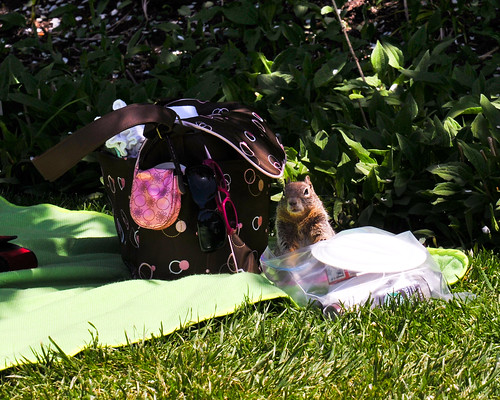Archivos de Diario para febrero 2012
01 de febrero de 2012

13 de febrero de 2012
Barn Owl
Breezy, rain, a bit of slushy snow, atypical weather in warmer than usual winter. With no snow on the ground at lower elevations, very few Bald Eagles and no Tundra Swans were seen at the Salt Creek portion of the BRMBR this afternoon. Did find a Barn Owl in his/her usual spot in the sugar beet sillo however.

17 de febrero de 2012
Wild Turkey?
Visited Liberty Park in search of a Wood Duck that had been reported on the pond there. No Duck, but I noticed some construction going on near the Aviary and decided to check it out. Surprised to see a large building on the north side of the Aviary and discovered it is the new gift shop/admissions area/ staff workspace and indoor birds exhibition area--quite a change from my last visit. I went inside to check it out and one of the staff approached me (must have been the camera bag and binos) and informed me that a Wild Turkey was roaming the grounds. Hadn't planned on going through the gate, but didn't want to miss this unique opportunity. I located the Turkey near the Destination Argentina exhibit and chased him around the grounds for a bit. I also attended a live bird demo in the new indoor facility and featured was an Aplomado Falcon. While the urban oasis Liberty Park and the Tracy Aviary with its ample supply of food have hosted a number of uncommon birds including Summer Tanager and Bald Eagle, the presence of the Turkey begs the question: "how did he get there?" Although good fliers, Turkey typically run/walk on the ground and aren't known to fly more than a 1/4 mile at a clip, which means he would have had to touch down in congested urban neighborhoods for at least 5 or 6 miles from the surrounding foothills.
Wild turkeys are not known to have existed in Utah during early white settlement. However, historical and archeological evidence suggests that wild turkeys co-existed with Native Americans in Utah. Attempts to introduce the eastern wild turkey failed. Seven Merriam's turkeys were first planted in the LaSal Mountains of Grand County in 1952 from stock obtained from Colorado. Established populations now occur in Grand, San Juan, Beaver, Iron, Kane, Washington, Garfield, Piute, and Wayne counties. The first hunt in Utah was held in October of 1963. (Populations established in additional counties since this DWR article was published.)
http://dwrcdc.nr.utah.gov/rsgis2/Search/Display.asp?FlNm=melegame

19 de febrero de 2012
Turkey?
The wild turkey is still running strolling the ground of Tracy Aviary. Notice him near the fence at the northeast corner. Not sure why staff does not attempt to relocate him.

21 de febrero de 2012
Snow and Spring Birds
Had one of the few decent snowfall accumulations of the winter last night and though it might be a good idea to head to Farmington Bay and look for Barn Owls. Stuff happened at ended up at Red Butte where we found the usual suspects, albeit in glorious winter sunshine. Early nesters appear to be pairing up. Spring just around the corner.

27 de febrero de 2012
Carp
Utah has one of the largest wintering populations of bald eagles in the lower 48 states with more than 1,200 counted in recent years. Eagles congregate at Farmington Bay during winter months to feed on carp and waterfowl as fresh water feeding grounds are frozen over. Typically in January and February, hundreds of eagles can be seen in close proximity along the eastern shore of the Great Salt Lake. This year the Eagles have be much more dispearsed due to the unusually warm and dry conditons that have prevailed this winter. One year I was fortunate to count almost 200 Eagles at Farmington Bay after a snow storm along the five mile auto route open to the general public. Today's count was 21 despite the ample presence of dead carp which is the result of the DWRs annual posioning program to reduce the species impact on waterfowl feeding areas. The warm weather has also made it more difficult to see other species. I estimated Tundra Swans at over 2, 000 individuals, but they seemed to favor locations furthers away from the dikes/road so no close up views. We also walked out to the Nature Center viewing area and watched a half-dozen Great Blue Herons busy construting nests on the artificial platforms. Along the way we saw a large flock of juvenile White-crowned Sparrows.
The specific problem with Carp at Farmington Bay Waterfowl Management Area is that they root the bottom of the impoundment's, as they seek food. The rooting action stirs silt and keeps the water turbid, so that sunlight cannot penetrate for photosynthesis that is required for submergent plant growth to take place. The plant growth is necessary to provide food for migratory waterfowl. Rotenone is typically used each February each year for treating impoundments like Farmington Bay Waterfowl Management Area. The dead Carp provide an abundant food supply for Bald Eagle and other birds.
Archivos
- Mes Notas
- Enero 2021 2
- Febrero 2020 1
- Noviembre 2019 1
- Julio 2018 2
- Abril 2018 1
- Octubre 2017 1
- Septiembre 2017 1
- Agosto 2017 4
- Mayo 2017 1
- Abril 2017 1
- Marzo 2017 1
- Octubre 2016 1
- Septiembre 2016 1
- Mayo 2016 4
- Junio 2015 1
- Mayo 2015 2
- Mayo 2014 1
- Octubre 2013 1
- Junio 2013 1
- Mayo 2013 2
- Junio 2012 1
- Mayo 2012 1
- Marzo 2012 3
- Febrero 2012 6




